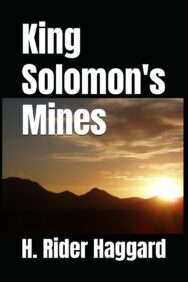 King Solomon’s Mines
King Solomon’s Mines
Unabridged Classic Authorized Edition
by H. Rider Haggard
When originally published in 1885 “King Solomon’s Mines” quickly became the best-selling book of the year, with the publisher working feverishly to print copies fast enough to meet demand. Ironically the book, which was written in less than four months and perhaps in as little as six weeks, had been rejected by numerous publishers who believed its novelty left it without commercial value.
It was both the first example of the popular “lost world” genre and the first English adventure novel set in Africa. The use of first-person subjective viewpoint and a narrative in familiar conversational style were radical departure from the ornate language and omniscient viewpoint of the books of the day.
This quality volume is not machine-scanned or a reproduction of an older edition. Prepared by human editors, it presents the complete unabridged text of H. Rider Haggard’s classic tale in a freshly edited and newly formatted edition printed on heavyweight bright white paper with a fully laminated cover. A generous 6″x9″ page size and 11-point print make this edition easier on the eyes than most trade or “grocery store” modern paperbacks.
Footnotes, including those ostensibly by “the editor” are part of the original text. Haggard’s spelling and punctuation were notoriously inconsistent, and his publishers and editors made little effort to clean up his manuscripts. Editors of reprints over the years have attempted to “guess” at “corrections”. We have chosen to follow the revised 1907 version approved by the author, rather than substitute our judgment for his as to changes.
The outline of the tale has become a staple storyline for adventure fiction, and tells of the search, through an unexplored region of Africa, for the lost brother of Sir Henry Curtis. Curtis and his companion, Captain Good, first search out Allan “Hunter” Quatermain, an old hand at African big-game hunting who agrees to lead the expedition despite his conviction that they will likely never return. Upon realizing that Curtis’ brother was searching for the lost mines of the biblical King Solomon, Quatermain produces a crude map, in which he never put much credence, and a letter supposedly written by a Portuguese explorer claiming to have found the fabulous diamond mines. The expedition is joined by the mysterious Umbopa, a native who seems out of place as a servant but is anxious to go along. Ultimately they reach the fabled destination, only to discover a lost civilization and see Umbopa’s secret revealed.
Sir Henry Rider Haggard (1856-1925) wrote “King Solomon’s Mines” on a bet, a five-shilling wager with his brother that he could write a story “half as good” as “Treasure Island”. Haggard had traveled extensively in Africa as a minor government staff official during the Zulu and Boer Wars, and the Allan Quatermain character was based largely on the colorful adventurers he encountered there. Other influences were the contemporary discovery of the diamond fields and the ruins of ancient civilizations.
“King Solomon’s Mines” was remarkable not only for its originality but for Haggard’s attitude toward native Africans. Unusual for writers in the colonial era, Haggard openly declared that many Africans were more noble and admirable than many of the Europeans who arrived in Africa, and his novels include complex and heroic native characters as well as evil and barbaric natives. “King Solomon’s Mines” includes an interracial romance to which Quatermain has no objection, but which he tries to discourage because of how it will be received when Captain Good returns to England.
Haggard penned several popular novels while traveling to various parts of the Empire in the cause of land reform and, like many Victorians, dabbled in spiritualism and the paranormal. Haggard’s most enduring characters, Allan Quatermain and Ayesha, were brought together in “She and Allan”, Haggard’s last major work.
Product details
Publisher: Apex Publications, Independently published (June 11, 2024)
Language: English
Paperback: 213 pages
ISBN: 979-8328137539
Item Weight: 13.6 ounces
Dimensions: 6 x 0.48 x 9 inches

